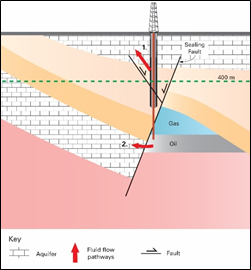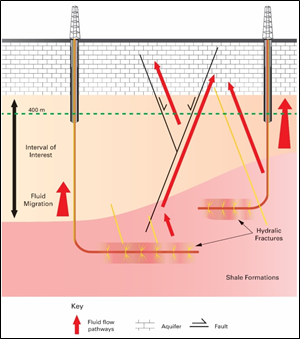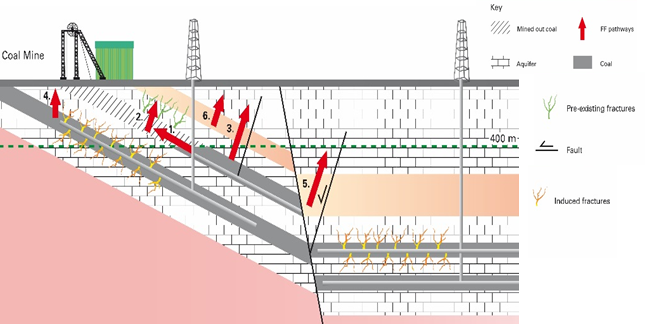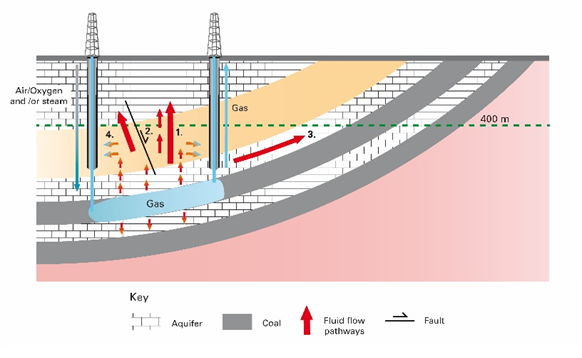Sources of potential sub-surface groundwater contamination from hydrocarbon development
As part of a jointly-funded BGS / Environment Agency study into the vulnerability of groundwater (3DGWV), BGS have developed a series of conceptualisations of the potential sources of sub-surface contamination of groundwater from hydrocarbon development. These conceptualisations include the release scenarios and pathways for sub-surface movement of contaminants for four main contamination scenarios:
- Conventional oil and gas: extracted from wells drilled into an oil reservoir. For reservoirs to form a source rock rich in hydrocarbons is needed. This has to have been buried sufficiently deeply to heat up and release the oil and or gas. A porous and permeable reservoir overlying the source rock is needed to contain the released oil or gas, and finally a relatively impermeable cap rock is required to trap the oil or gas in the reservoir.
- Shale gas: a natural gas, primarily consisting of methane as well as other hydrocarbons trapped within the source shale formations that have been buried to sufficient depths to produce hydrocarbons. Due to the low permeability of the shales, to release the shale gas and produce it in commercial quantities it is necessary to fracture the shale under pressure, typically using a series of horizontal wells.
- Coal-bed methane: methane that is adsorbed into coal. It is in a near-liquid state within the matrix and fractures in coal deposits and is extracted by depressurisation of the coal leading to de-sorbtion of the methane. The released methane is produced through wells to the ground surface.
- Underground coal gasification: the production of gasses, including methane, by the in-situ gasification of un-mined coal seams. Injection wells supply air, oxygen and steam to ignite the underground coal, with produced gas being extracted from wells to the ground surface.
Conventional oil and gas

Conventional oil and gas is typically trapped in reservoirs bounded by a combination of impermeable cap rocks and low permeability faults. The hydrocarbons are accessed by drilling into the reservoir. If the well has not been constructed correctly, groundwater contamination can occur along the borehole (1.). This may be a particular issue with old wells. For this reason BGS is researching the potential for contamination of groundwater from abandoned wells. If faults bounding the reservoir or those intersecting the wells are not fully sealing then this may also be a potential pathway for contamination of groundwater water (2.)
Shale gas

Shales that are targets for commercial methane production are typically about 1 km or more below the ground surface, whereas aquifers that are used for groundwater supplies are typically a few 10s of metres to a couple of hundred meters below the ground surface. The intervening rocks form a natural barrier to any contamination released during hydraulic fracturing. However, a number of potential pathways of contamination exist. Where the vertical separation between shale and aquifer is limited and if there are no low permeability rocks in the intervening interval then there is a risk of groundwater contamination from hydraulic fracturing of shales (1.). Groundwater contamination may occur along pre-existing high permeability faults or fracture systems (2a.) or where hydraulic fractures intersect such systems (2b.). If wells have not been constructed correctly, groundwater contamination can occur along boreholes (1.) or along abandoned wells.
Coal-bed methane

In England, coal beds are often interbedded with rocks that form Secondary Aquifers in the near surface. This, in combination with the historic excavation of shafts and adits to extract coal as well as the presence of natural fractures or cleats in the coal deposits may provide pathways (1. and 2.) for methane to move into shallow groundwater systems. Many coal bearing-areas are faulted and these faults, if permeable, may form pathways for methane to shallow groundwater (3.). Induced fracturing during the production of coal bed methane may aid the migration of methane into secondary aquifers in close proximity to the coal seam being developed (4.). Finally, as with other unconventional hydrocarbon production schemes, boreholes if not properly constructed may act as potential pathways for contamination of groundwater (5.).
Underground coal gasification

In England, coal beds are often interbedded with rocks that form Secondary Aquifers in the near surface and groundwater may be vulnerable to contamination. High pressures and temperature during underground coal gasification can induce convection of contaminants through permeable pathways (1.). Pre-existing faults (2.) may act as pathways for contamination and also contribute to cavity collapse, increasing the overall permeability of overlying rocks (3.). As with other unconventional hydrocarbon production schemes, boreholes if not properly constructed may act as potential pathways for contamination of groundwater (4.)
Contact
Please contact BGS Enquiries for more information.







